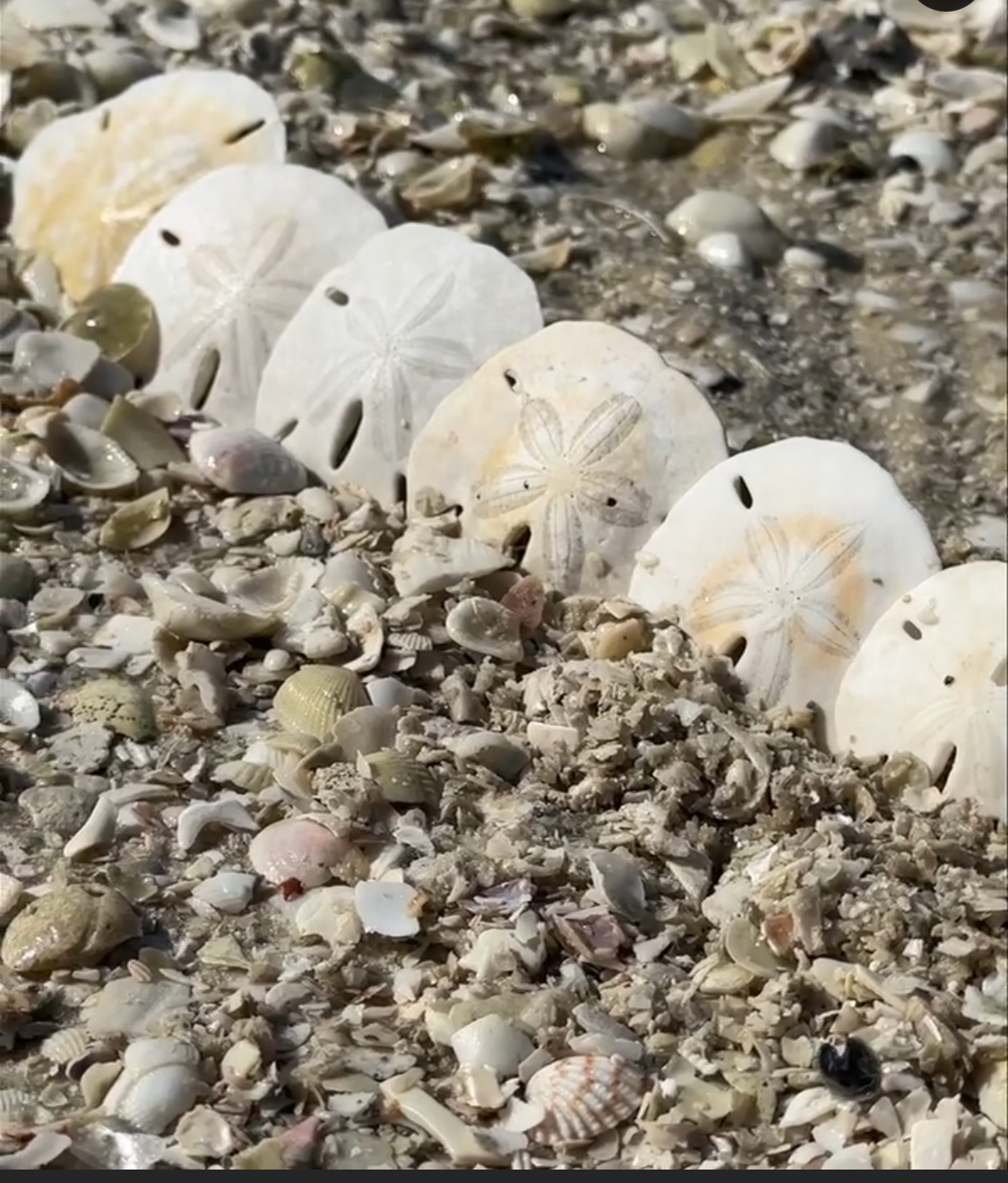In the tranquil waters off the coast of Southwest Florida, amidst the swaying seagrasses and gently lapping waves, lies a hidden treasure waiting to be discovered—the enigmatic sand dollar. As a seasoned Local Shelling Expert and Florida Master Naturalist with Treasure Seekers Shell Tours, I’ve unveiled the secrets of these captivating creatures, diving deep into their fascinating world.
Scientific Insights:
Habitat: Sand dollars, echinoderm kin to sea stars and urchins, favor shallow sandy seabeds in temperate and tropical zones. Southwest Florida’s pristine shores provide the perfect habitat for these marvels.
Foodies of the Deep: Deceptive in their stillness, sand dollars are surprisingly active feeders. Using their spines and tube feet, they capture microscopic algae and organic particles, acting as marine vacuum cleaners and promoting healthy coastal ecosystems. They play a vital role in maintaining the health of coastal ecosystems by filtering seawater and recycling nutrients.
Nature’s Architects: The sand dollar’s intricate skeletal structure, resembling a delicate flower or starburst, serves a dual purpose. This distinctive design serves both functional and protective purposes, enabling efficient movement through the sand and offering camouflage from potential threats.
Reproduction: Sand dollars reproduce through spawning, releasing eggs and sperm into the water column where fertilization occurs. The larvae then develop into juveniles, eventually settling on the ocean floor to begin their adult life cycle.
Predators: Sand dollars face predation from a variety of marine organisms, including sea stars, crabs, and certain species of fish. Their flattened, disc-shaped bodies provide some defense against predators, allowing them to burrow into the sand for protection.
Unearthing Rarities: The Ten Thousand Islands National Wildlife Refuge is a haven for sand dollars. Scattered along the sandy shores of remote islands like Panther Key and Pavilion Key, these elusive treasures await discovery.
Become a Sand Dollar Savant:
Spotting Secrets: Keep an eye out for shells with five distinct keyhole-shaped slots – a signature sand dollar feature. These openings house tube feet used for movement and feeding.
Touch Tells: Another telltale sign – fine, hair-like spines covering the shell. These tiny projections help the sand dollar anchor itself and deter predators.
Historical Significance:
Throughout history, sand dollars have held cultural significance. Christian folklore interprets the shell’s markings as symbols of the crucifixion, making it a symbol of faith and redemption.
Respectful Collection:
The allure of finding a perfect sand dollar is undeniable for collectors. However, responsible practices are crucial to safeguard these delicate ecosystems. Treasure Seekers Shell Tours champions sustainable harvesting through guided shelling excursions. You’ll learn about sand dollars while minimizing environmental impact.
Frequently Asked Sand Dollar Questions:
- What’s Inside A Sand Dollar? A delicate internal structure called a “test” made of calcium carbonate plates in a radial pattern.
- What is a Sand Dollar? A type of echinoderm, closely related to sea urchins and starfish, with a flattened, disc-shaped shell.
- What Do Sand Dollars Look Like? Imagine a round, flattened shell covered in fine spines, with five keyhole openings and a beautiful flower-like design.
- Sand Dollar Shelling Tours? Treasure Seekers Shell Tours offers top-rated shelling adventures in the Ten Thousand Islands, providing expert guidance and access to pristine shelling grounds.
- Shelling for Sand Dollars in Marco Island? Absolutely! Marco Island boasts pristine beaches teeming with marine life, making it a great sand dollar hunting spot.
- Is Sand Dollar Shelling Fun? You bet! It’s an exciting adventure that allows you to connect with nature and discover the ocean’s hidden treasures.
- Sand Dollar Colors? Sand dollars are typically a pale off-white, though color variations can occur due to age and environmental factors.
Preservation Tips for Collected Sand Dollars:
- Handle with Care: Sand dollars are delicate creatures, and their shells can be fragile. When collecting or handling them, avoid applying excessive pressure or squeezing, as this can cause them to break or crack.
- Rinse with Freshwater: After collecting sand dollars from the beach, gently rinse them with fresh water to remove any sand, salt, or debris. Use a soft brush or your fingers to gently scrub away stubborn particles, being careful not to damage the delicate spines or surface of the shell.
- Air Dry Thoroughly: Allow the rinsed sand dollars to air dry completely in a cool, shaded area away from direct sunlight. Placing them on a soft towel or mesh drying rack can help facilitate airflow and prevent them from sticking to surfaces.
- Avoid Harsh Chemicals: Refrain from using harsh chemicals or cleaning agents to sanitize or treat collected sand dollars, as these substances can damage their delicate structures. Opt for natural cleaning methods, such as gentle rinsing and air drying, to preserve their integrity.
- Store Properly: Once dry, store sand dollars in a cool, dry place away from moisture and humidity to prevent them from becoming brittle or discolored over time. Avoid storing them in airtight containers or plastic bags, as this can trap moisture and promote mold growth.
- Display with Care: If you plan to display your collected sand dollars, choose display methods that minimize handling and exposure to environmental factors. Consider framing them in shadow boxes or displaying them on shelves or mantels away from direct sunlight and high humidity.
By following these preservation tips, you can ensure that your collected sand dollars remain beautiful and intact for years to come, serving as cherished mementos of your shelling adventures in Southwest Florida.
The Enchantment Endures:
By delving into the captivating world of sand dollars, you’ll gain a deeper appreciation for the wonders of nature and the vibrant marine life gracing Southwest Florida’s shores. Join Treasure Seekers Shell Tours on a shelling adventure unlike any other and embark on a journey of discovery!
To further enhance your understanding of sand dollars and plan your own shelling adventure in Southwest Florida, be sure to check out our informative videos on Treasure Seekers Shell Tours’ YouTube channel: Shelling in the Ten Thousand Islands.
